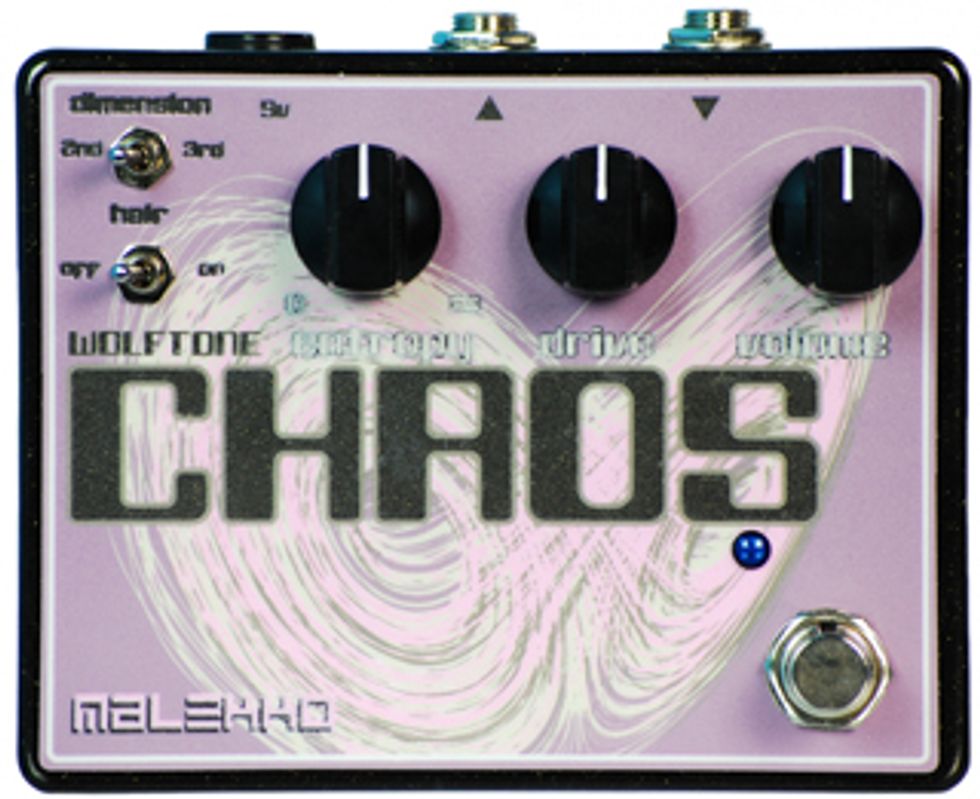
There are a lot of unruly fuzzes and unique distortions out there these days, but back in the early 2000s, pedal designer Todd Wolfgram and Studio Electronics introduced the Wolftone Helium and Chaos—pedals that became legendary in fuzz circles for their very original, unusual takes on octave and modulated distortion. Now, Malekko Heavy Industries has enlisted Wolfgram to bring back the Helium and the Chaos, the latter of which is reviewed here.
Like the original, the Wolftone Chaos is capable of tricks that make it more than just another fuzz with an unconventional voice. Many players will use terms like “ring-mod-like” to describe its tones, but the Chaos actually delivers much more than that—and more than a simple replication of the Studio Electronics original. Its impressive tones range from radical to understated.
Something that you don’t understand…
The Chaos features three knobs, two toggles, a true-bypass footswitch, a standard 9V connection jack, and an internal battery connector. The two toggles control dimension (second- and third-order harmonics) and hair (which engages or disengages an upper-harmonic boost), while the knobs control entropy, drive, and volume. All of the controls interact with each other to a significant extent, which can sometimes make it difficult to, say, dial in a previously used sound that you can hear in your head but can’t remember visual knob cues for.
Build quality feels on par with the original Studio Electronics Wolftone: Switches feel solid, pots turn smoothly, and the case feels sturdy as brick house. The shape is much more pedalboard-friendly than the original, however. The graphics and overall aesthetics are arguably a huge improvement over the wine red (or is it blood red?) of the original Studio Electronics box. Instead, Malekko adorned the pedal with an infinity sign made of two interlinking vortexes that pretty much sum up how the pedal controls interact with each other.
Looking under the hood reveals some surprises. Lurking inside you’ll find a transformer typically found in octave-up circuits like the Tycobrahe Octavia—but the Wolftone Chaos isn’t an octave-up unit. It also uses a lot of diodes. Clearly, this is not your typical fuzz/distortion, and it’s little wonder that it yields very unique tones.
Ratings
Pros:
Incredibly unique tones. Great build quality. Solid price and improved features compared to the original pedal.
Cons:
Can be unruly. Steep learning curve.
Tones:
Ease of Use:
Build:
Value:
Street:
$159
Malekko Heavy Industry
malekkoheavyindustry.com
Bark at the Moon
Paired with a P-90-equipped Gibson Firebird and a Fender Twin Reverb, the Chaos delivered the strange filtered textures I was looking—and hoping—for, after a quick get-acquainted session. Sorting out the interactive controls isn’t the only process that requires some patience and experimentation, though: It’s very sensitive to playing dynamics, and tones vary wildly depending on how hard you hit the strings, what volume and tone the guitar is set to, pickup selection, amp volume, and even where you stand in relation to the amp with the guitar. For instance, rolling back on the guitar volume, messing with the dimension and hair switches in combination with the entropy switch and gain, I could get a squelchy, envelope-filtered kind of ring-mod distortion. The only other time I’ve come close to that sound is during the last few seconds before a fuzz pedal’s battery gives out. Awesome!
While the Chaos can sound a little unruly at first, I was able to get almost octave-like fuzz with a really nice filtered afterglow. And unlike most fuzz pedals, it does not gate unless you set it to do so—which makes the pedal much more versatile and musical for more conventional octave fuzz-like applications.
The Verdict
If you’re looking for nasty or demented fuzz tones, the Malekko Wolftone Chaos is a very unique jumping-off point: Ring-modulated fuzz is no easy trick to pull of—there’s no shortage of pedals that fall short while attempting it—but the Chaos nails it. But it isn’t a one-trick pony, either. However, its sonic depth does require patience—the controls are so interactive that it takes some time to crack open all its secrets. If you’re looking for standard fuzz tones or something that sounds incredible right out of the box, you may not grok this pedal. But if you’re an adventurous guitarist who isn’t afraid of sputtering filtered tones, you are going to love this pedal and the seemingly thousands of unconventional tones lurking within.











![Rig Rundown: Russian Circles’ Mike Sullivan [2025]](https://www.premierguitar.com/media-library/youtube.jpg?id=62303631&width=1245&height=700&quality=70&coordinates=0%2C0%2C0%2C0)





